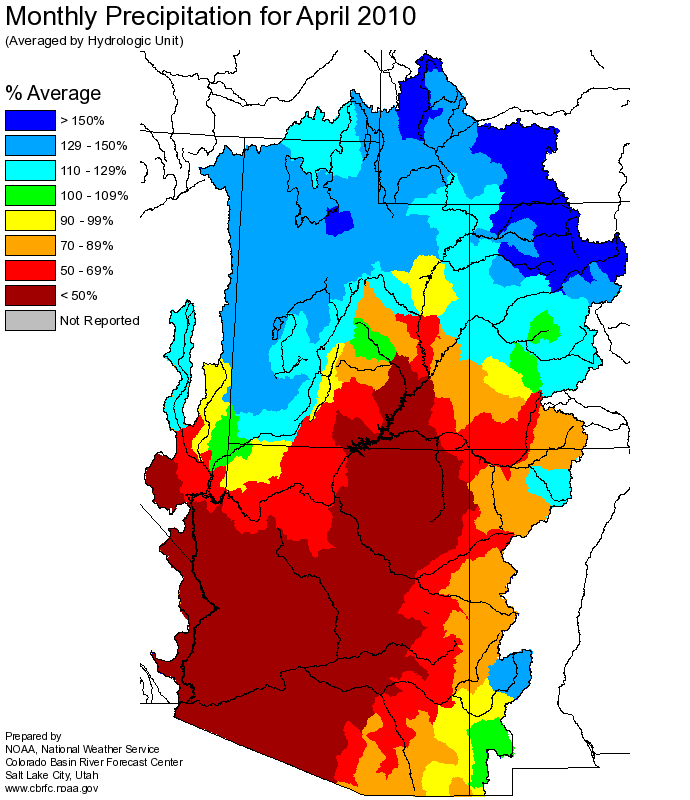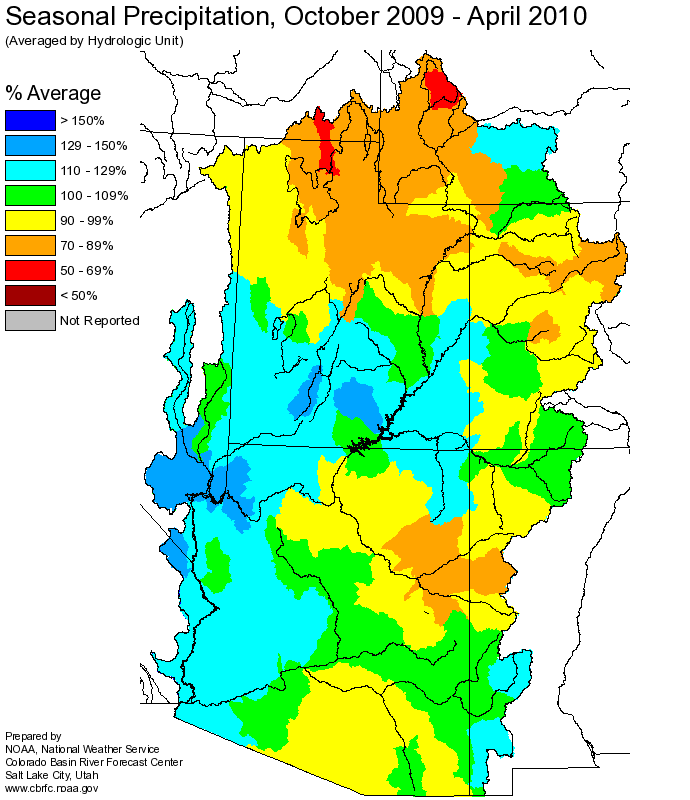Note: This publication is currently undergoing major revisions. The current publication will be replaced with a new publication based on stakeholder requirements and scientific advances. We expect to begin sharing details on this soon. If you have input on content, format, or publication frequency at any time, please contact us at cbrfc.webmasters@noaa.gov.Lake Powell Water Supply Outlook, May 1, 2010Lake Powell Water Supply Outlook, May 1, 2010
Contents
Lake Powell Sub-Basin Summaries
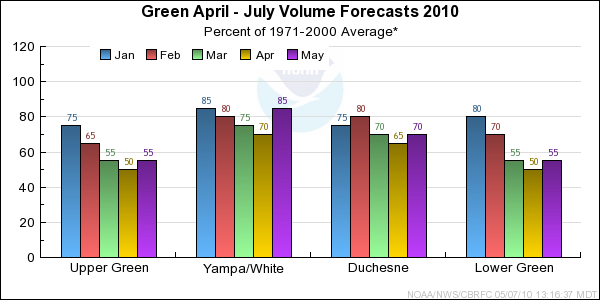
*Median of forecasts within each basin.
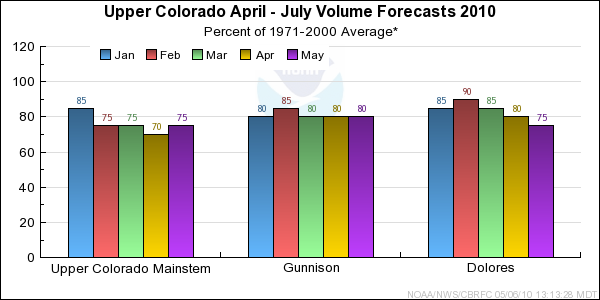
*Median of forecasts within each basin.
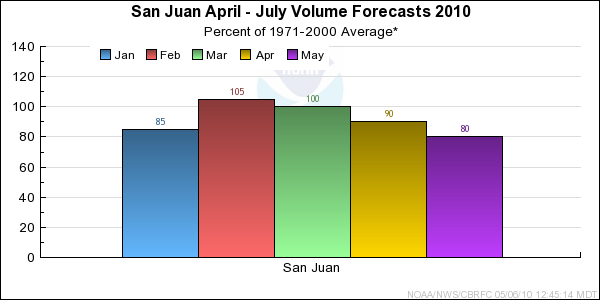
*Median of forecasts within each basin.
Upper Green Basin Conditions
The following conditions influenced this month's forecasts:
Precipitation:
Seasonal October through April
precipitation was 80 percent of average
in the Upper Green basin. April
precipitation was 140 percent of average.
Snow:
May 1st snow water equivalent was near 60 percent of average over the entire basin.
--- Upper Green basin
snow
water equivalent plot.
Streamflow:
April streamflow was near 70 percent of average.
Soil Moisture:
Modeled
soil
moisture states ranged from below average to near average heading into the winter.
Climate Forecasts:
Climate forecasts were not a factor because there is not a strong correlation
between El Nino conditions and winter precipitation in the Upper Green basin.
Forecast Summary:
Due to below average seasonal precipitation to date and much below average
May 1st snow water equivalent values the May through July streamflow
volume forecasts are much below average at this time. These
forecasts
range between 41 and 79 percent of average, with a median value of 50 percent.
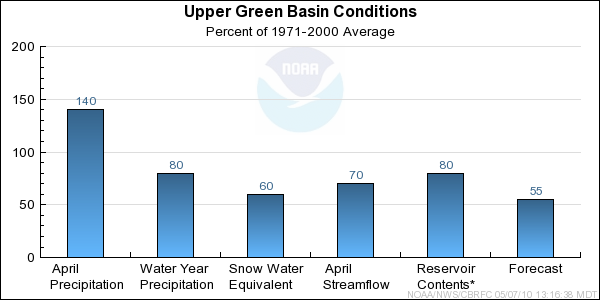
* Percent usable capacity, not percent average contents.
Click for multi-month Graph.
Yampa/White Basin Conditions
The following conditions influenced this month's forecasts:
Precipitation:
Seasonal October through April
precipitation was 95 percent of average
in the Yampa/White basin. April
precipitation was 155 percent of average.
Snow:
May 1st snow water equivalent was 80 percent of average in the basin as a whole.
--- Yampa basin
snow
water equivalent plot.
Streamflow:
April streamflow was near 95 percent of average.
Soil Moisture:
Modeled
soil
moisture states were near average heading into the winter for the Little Snake
and White River basins. Modeled states ranged from below average to near average
heading into winter for the Yampa basin.
Climate Forecasts:
Climate forecasts were not a factor because there is not a strong correlation
between El Nino conditions and winter precipitation in the Yampa/White basin.
Forecast Summary:
Due to near average seasonal precipitation to date and below average
May 1st snow water equivalent values the May through July streamflow
volume forecasts are below average at this time. These
forecasts range
between 46 and 88 percent of average, with a median value of 75 percent.
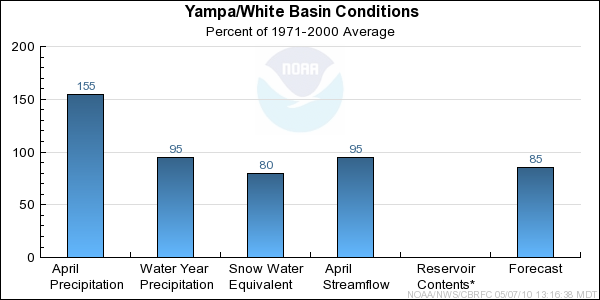
* Percent usable capacity, not percent average contents.
Click for multi-month Graph.
Duchesne Basin Conditions
The following conditions influenced this month's forecasts:
Precipitation:
Seasonal October through April
precipitation was 80 percent of average
in the Duchesne basin. April
precipitation was 130 percent of average.
Snow:
May 1st snow water equivalent was 65 percent of average in the basin as a whole.
--- Duchesne basin
snow
water equivalent plot.
Streamflow:
April streamflow was near 65 percent of average.
Soil Moisture:
Modeled
soil
moisture states were much below average to below average heading into the winter.
Climate Forecasts:
Climate forecasts were not a factor because there is not a strong correlation
between El Nino conditions and winter precipitation in the Duchesne basin.
Forecast Summary:
Due to below average seasonal precipitation to date and much below average
May 1st snow water equivalent values the May through July streamflow
volume forecasts are much below average at this time. These
forecasts range between 50 and 80 percent of average,
with a median value of 70 percent.
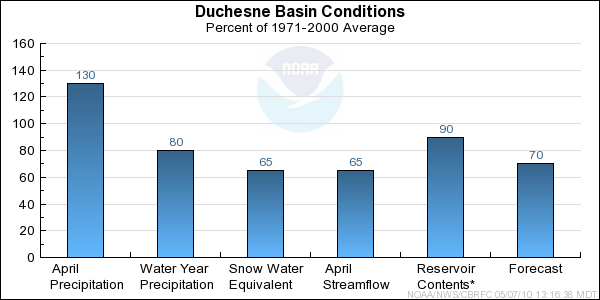
* Percent usable capacity, not percent average contents.
Click for multi-month Graph.
Lower Green Basin Conditions
The following conditions influenced this month's forecasts:
Precipitation:
Seasonal October through April
precipitation was 95 percent of average
in the headwaters of the Lower Green basin. April
precipitation was 100 percent of average.
Snow:
May 1st snow water equivalent was 80 percent of average in the basin as a whole. The Price and San Rafael headwaters
did not receive as much snow as those further to the south. The May 1st snow water equivalent was 65 percent of average
in the Price and San Rafael basin.
--- Price basin
snow
water equivalent plot.
Streamflow:
April streamflow was near 60 percent of average.
Soil Moisture:
Modeled
soil
moisture states were much below average heading into the winter.
Climate Forecasts:
Climate forecasts were not a factor because there is not a strong correlation
between El Nino conditions and winter precipitation in the Lower Green basin.
Forecast Summary:
Due to the below average May 1st snow water equivalent values, and the much below average soil moisture heading into winter
the May through July streamflow volume forecasts are much below average at this time. These
forecasts
range between 48 and 64 percent of average, with a median value of 55 percent.
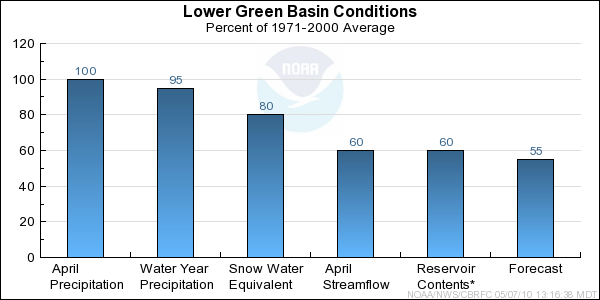
* Percent usable capacity, not percent average contents.
Click for multi-month Graph.
Upper Colorado Mainstem Basin Conditions
The following conditions influenced this month's forecasts:
Precipitation:
Seasonal October through April
precipitation
was near 90 percent of average in the Upper Colorado mainstem basin.
April
precipitation was near 140 percent of average.
Snow:
May 1st snow water equivalent was near 75 percent of average in the basin
as a whole.
--- Upper Colorado basin
snow
water equivalent plot
Streamflow:
April streamflow was near 110 percent of average.
Soil Moisture:
Modeled
soil
moisture states were near average heading into the winter.
Climate Forecasts:
Climate forecasts were not a factor because there is not a strong correlation
between El Nino conditions and winter precipitation in the Upper Colorado mainstem basin.
Forecast Summary:
Precipitation and streamflows were much above average and above average for the month of April
in the Upper Colorado Basin. However, May 1st snow water equivalent remained below average at
75%. May through July streamflow volume forecasts range from 58 to 85 percent of average, with a
median value of 72%. April precipitation and streamflow conditions resulted in a 5-15% increase
to the April through July volume forecasts for most locations. The Upper Colorado basin April
through July volume forecasts now range between 60 and 87 percent of average, with a median
value of 75%.
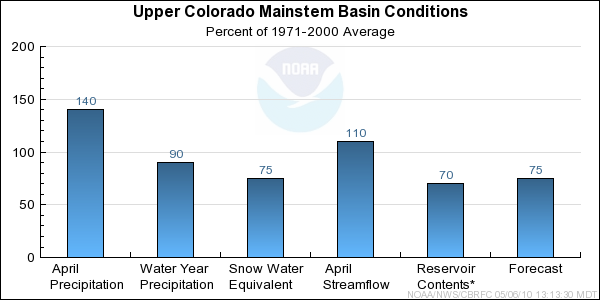
* Percent usable capacity, not percent average contents.
Click for multi-month Graph.
Gunnison Basin Conditions
The following conditions influenced this month's forecasts:
Precipitation:
Seasonal October through April
precipitation was 95 percent of average
in the Gunnison Basin. April
precipitation was 115 percent of average.
Snow:
May 1st snow water equivalent was 80 percent of average in the Gunnison Basin.
--- Gunnison basin
snow
water equivalent plot
Streamflow:
April streamflow was 125 percent of average.
Soil Moisture:
Modeled
soil
moisture states were below average heading into the winter.
Climate Forecasts:
Climate forecasts were not a factor because there is not a strong correlation
between El Nino conditions and winter precipitation in the Gunnison Basin.
Forecast Summary:
April precipitation was above average in the Gunnison Basin as a whole, as were the monthly
streamflow volumes. However, May 1st snow water equivalent for the Gunnison dropped to
below average at 80%. May through July volume forecasts range from 65 to 84 percent of
average, with a median value of 75%. This resulted in very little change overall to the
April through July volume forecasts, with some points going up a little and others down a
little. The Gunnison Basin April through July
forecasts now range
between 73 and 91 percent of average, with a median value of 80%.
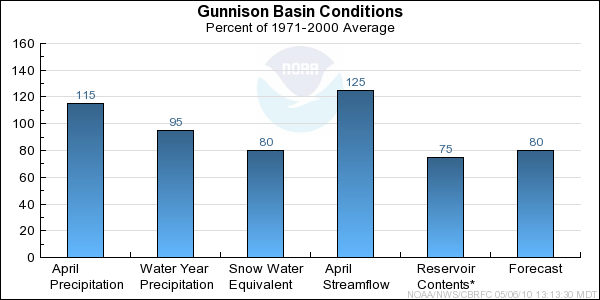
* Percent usable capacity, not percent average contents.
Click for multi-month Graph.
Dolores Basin Conditions
The following conditions influenced this month's forecasts:
Precipitation:
Seasonal October through April
precipitation was 105 percent of average
in the entire Dolores Basin. April
precipitation was 105 percent of average.
Snow:
May 1st snow water equivalent was 70 percent of average in the Dolores Basin.
--- Dolores basin
snow
water equivalent plot
Streamflow:
April streamflow was 120 percent of average.
Soil Moisture:
Modeled
soil
moisture states were below to much below average heading into the winter.
Climate Forecasts:
The correlation of El Nino and May through July water volumes in the Dolores Basin is so small that
it did not influence the forecast process.
Forecast Summary:
Although April precipitation was near average in the Dolores Basin as a whole, the Dolores
River headwaters were once again below average at 85%. In addition, the May 1st snow water
equivalent was below average at 70%. May through July volume forecasts range from 62 to 75
percent of average, with a median value of 67%. Even with the above average April streamflow
volumes, this resulted in about a 5% decrease in the April through July forecast volumes.
The Dolores Basin April through July
forecasts now range between
75 and 80 percent of average, with a median value of 75%.

* Percent usable capacity, not percent average contents.
Click for multi-month Graph.
San Juan Basin Conditions
The following conditions influenced this month's forecasts:
Precipitation:
Seasonal October through April
precipitation was 100
percent of average in the San Juan Basin.
April
precipitation was 70 percent of average.
Snow:
May 1st snow water equivalent was 75 percent of average for the San Juan Basin
as a whole; it was 65% in the Animas Basin and 85% in the area above Navajo
Reservoir.
--- Animas River Basin
Snow Plot.
--- Above Navajo Basin
Snow Plot.
Streamflow:
Streamflow for the entire San Juan Basin was 120 percent of average in April.
Seasonal streamflow since October was 65% due to the much below average summer
through fall precipitation.
Soil Moisture:
Modeled
soil
moisture as of November 1st, 2009 was below to much below average.
Climate Forecasts:
The correlation of El Nino and May through July water volumes in the San Juan Basin is so small that
it did not influence the forecast process.
Forecast Summary:
April precipitation was below average in the San Juan Basin and the May 1st snow
water equivalent was below average as well, having decreased quite a bit from
last month. May through July volume forecasts range from 66 percent to 93
percent of average with a median value of 75%. Even with the above average
April streamflow volumes, this resulted in up to 10% decreases at some points in
the April through July forecast volumes. The San Juan Basin April through July
forecasts now range between 45 and 98 percent of
average, with a median value of 80%.
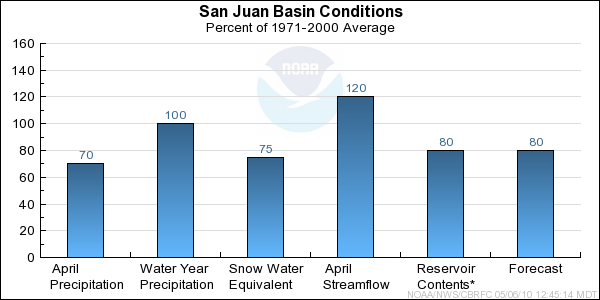
* Percent usable capacity, not percent average contents.
Click for multi-month Graph.
Differences between the full period forecasts and the residual forecasts may not exactly equal the actual observed volumes due to rounding conventions (see Definitions section).
Reservoir Monthly Inflow Forecasts
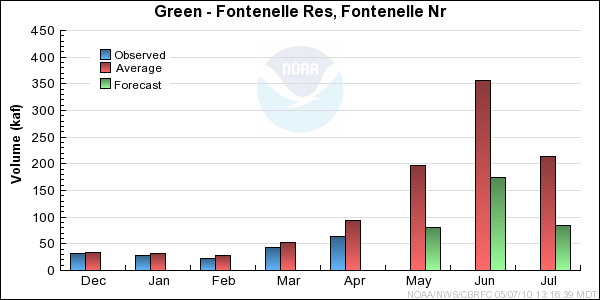
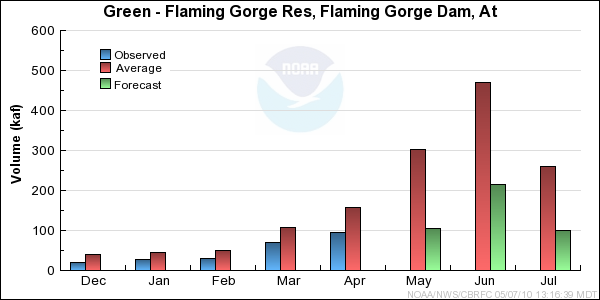
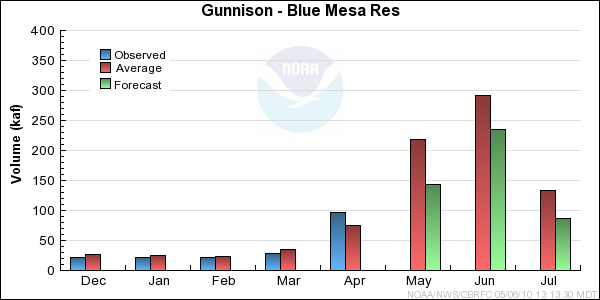

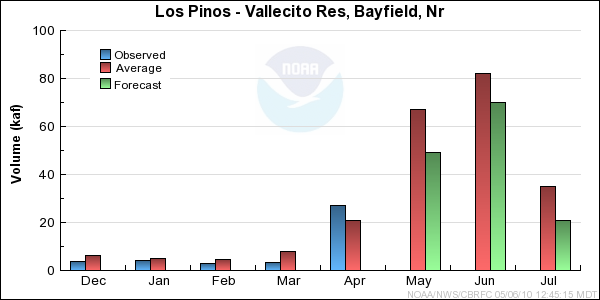
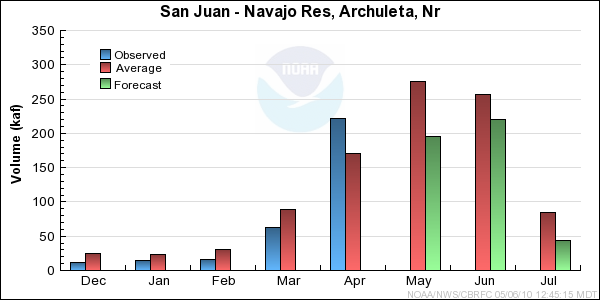
Monthly Streamflows
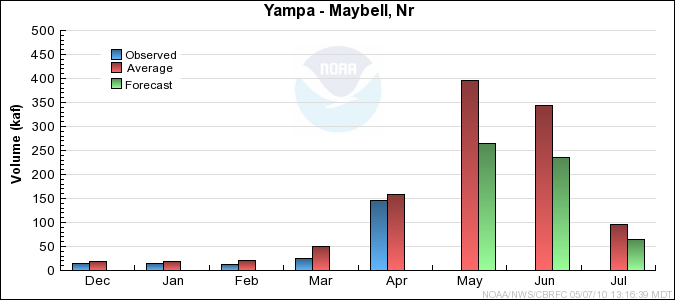
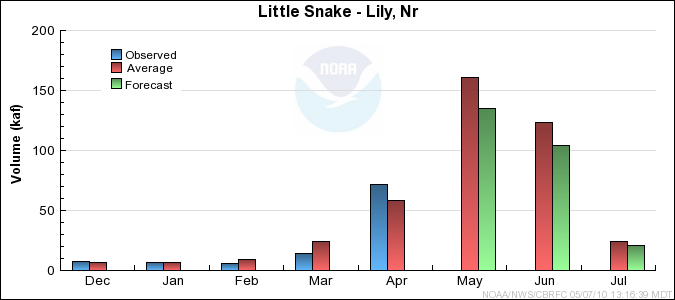
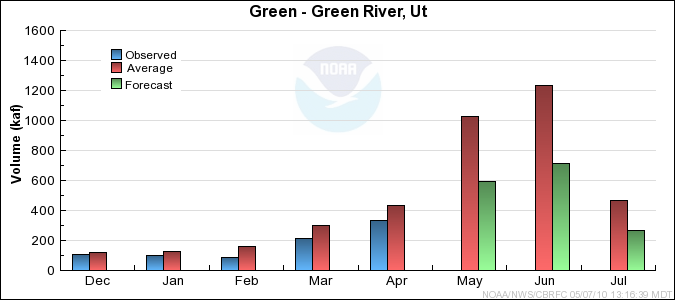
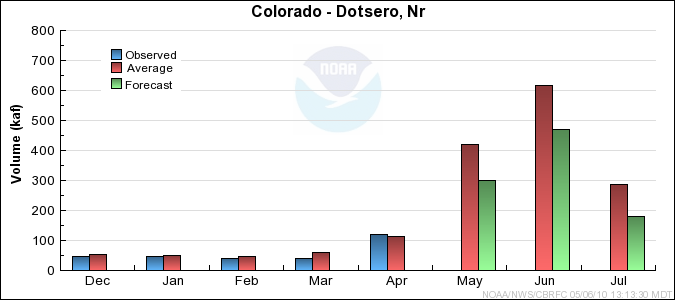
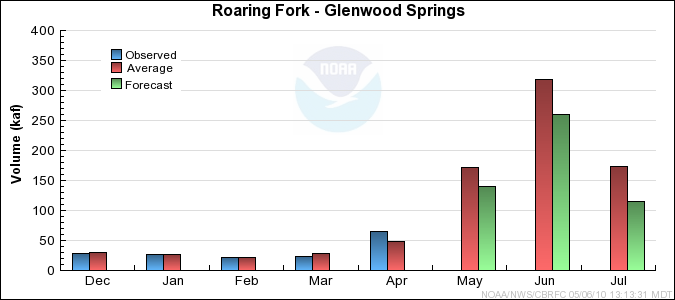

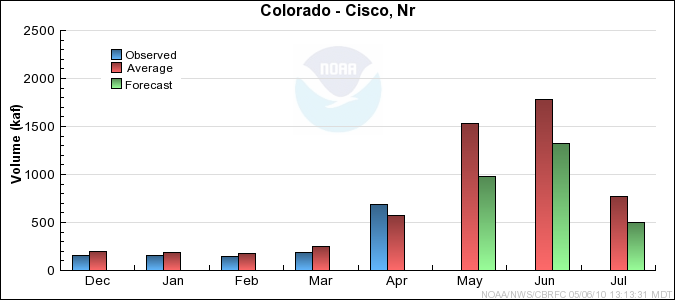
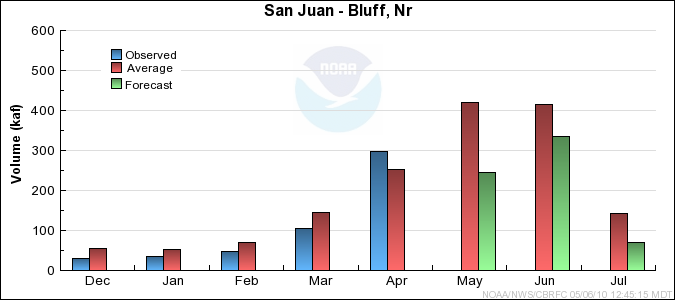
Precipitation Maps
